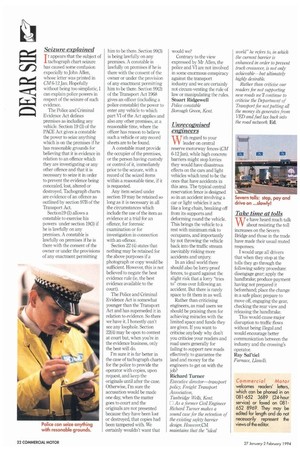Seizure explained
Page 24

If you've noticed an error in this article please click here to report it so we can fix it.
It appears that the subject of tachograph chart seizure has caused some confusion expecially to John Allen, whose letter was printed in CM 6-12 Jan. Hopefully without being too simplistic, I can explain police powers in respect of the seizure of such evidence.
The Police and Criminal Evidence Act defines premises as including any vehicle. Section 19 (3) of the PACE Act gives a constable the power to seize anything which is on the premises if he has reasonable grounds for believing that it is evidence in relation to an offence which they are investigating or any other offence and that it is necessary to seize it in order to prevent the evidence being concealed, lost, altered or destroyed. Tachograph charts are evidence of an offence as outlined by section 97B of the Transport Act.
Section19 (1) allows a constable to exercise his powers under section 19(3) if he is lawfully on any premises. A constable is lawfully on premises if he is there with the consent of the owner or under the provisions of any enactment permitting him to be there. Section 99(3) is being lawfully on any premises. A constable is lawfully on premises if he is there with the consent of the owner or under the provision of any enactment permitting him to be there. Section 99(2) of the Transport Act 1968 gives an officer (including a police constable) the power to enter any vehicle to which part VI of the Act applies and also any other premises, at a reasonable time, where the officer has reason to believe such a vehicle or any record sheets are to be found.
A constable must provide the occupier of the premises, or the person having custody or control of it, immediately prior to the seizure, with a record of the seized items within a reasonable time, if it is requested.
Any item seized under section 19 may be retained so long as it is necessary in all the circumstances which include the use of the item as evidence at a trial for an offence, for forensic examination or for investigation in connection with an offence.
Section 22 (4) states that nothing may be retained for the above purposes if a photograph or copy would be sufficient. However, this is not believed to negate the best evidence rule (ie, the best evidence available to the court).
The Police and Criminal Evidence Act is somewhat younger than the 'fransport Act and has superseded it in relation to evidence. So there we have it I honestly can't see any loophole. Section 22(4) may be open to contest at court but, when you're in the evidence business, only the best will do.
I'm sure it is far better in the case of tachograph charts for the police to provide the operator with copies, upon request, and keep the originals until after the case. Otherwise, I'm sure the accusation would be made one day, when the matter goes to court and the originals are not presented because they have been lost or destroyed, that copies had been tampered with. We certainly wouldn't want that would we?
Contrary to the view expressed by Mr Allen, the police and VI are not involved in some enormous conspiracy against the transport industry and we are certainly not circum-venting the rule of law or manipulating the rules. Stuart Ridgewell
Police constable Borough Green, Kent.




















































































